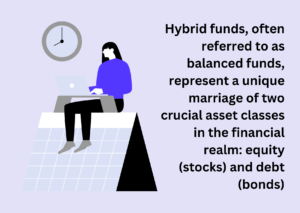Investing can be a daunting task, especially for those new to the financial world and Hybrid Mutual Funds can be that avenue that helps make this simple. With a plethora of options available, choosing the right investment strategy requires careful consideration. One option gaining popularity among investors is hybrid funds. In this comprehensive guide, we’ll delve deeper into the world of hybrid funds, breaking down the basics in a way that’s easy to understand.

Understanding the Essence of Hybrid Funds
Hybrid funds, often referred to as balanced funds, represent a unique marriage of two crucial asset classes in the financial realm: equity (stocks) and debt (bonds). By blending these diverse instruments into a single investment product, hybrid funds aim to provide investors with a balanced and diversified portfolio.
Diversification Strategies in Hybrid Funds
Hybrid funds employ various strategies to allocate funds across equity and debt instruments, catering to different risk appetites and financial objectives. Let’s explore the primary types of hybrid funds:
1. Equity-Oriented Hybrid Funds:
These funds predominantly invest in equities, with a smaller allocation to debt instruments. Designed for investors seeking capital appreciation with a moderate level of risk, they harness the potential for growth in the stock market. The key strategy here is to identify high-potential stocks and sectors while maintaining a safety net through debt investments.
2. Debt-Oriented Hybrid Funds:
Contrary to their equity-focused counterparts, these funds allocate a larger portion of their assets to debt instruments. This strategy aims to provide stability and regular income, making them suitable for conservative investors focused on capital preservation. The fund manager might focus on selecting a mix of high-quality bonds to generate a steady stream of income while minimizing risk.
3. Balanced Hybrid Funds:
Striking a harmonious balance between equity and debt, these funds provide a moderate level of risk and return. They cater to investors looking for a well-rounded approach that balances growth potential with stability. The strategy involves adjusting the allocation based on market conditions, ensuring that the portfolio remains resilient to market fluctuations.
Unpacking the Benefits of Hybrid Funds
1. Diversification as a Risk Mitigator:
Hybrid funds spread investments across different asset classes, reducing the impact of poor performance in a single area on the overall portfolio. This diversification acts as a shield against market volatility. For example, if equities face a downturn, the impact on the overall portfolio is cushioned by the stability of debt instruments.
2. Effective Risk Management:
The combination of equities and debt helps manage risk effectively. While equities offer growth potential, the stability of debt instruments acts as a cushion, tempering the overall volatility. This risk management strategy becomes particularly beneficial during turbulent market conditions, providing a smoother investment experience.
3. Flexibility in Asset Allocation:
Hybrid funds provide fund managers with the flexibility to adapt to changing market conditions. This nimbleness allows for adjustments to the fund’s composition for optimal returns, a key advantage in dynamic market environments. For instance, in a bullish market, the fund manager might tilt the allocation more towards equities to capture potential gains, and in a bearish market, they might increase the allocation to debt for stability.
4. Convenience for Investors:
For individuals seeking a balanced portfolio without the intricacies of managing individual stocks and bonds, hybrid funds provide a convenient and accessible solution. The benefit here is not just financial but also in terms of time and effort saved. Investors can enjoy the advantages of diversification without the need for active management.
Considerations for Prospective Investors
1. Assessing Risk Tolerance:
Before selecting a hybrid fund, it’s crucial to assess your risk tolerance. Equity-oriented funds carry higher volatility, while debt-oriented ones offer stability. Understanding your risk appetite is paramount.
2. Defining Investment Horizon:
Different hybrid funds suit different timeframes. Determine your investment horizon – whether it’s short, medium, or long term – to align your investment strategy with your financial goals.
3. Evaluating Expense Ratios:
Consider the expense ratios associated with the fund. Lower expenses can positively impact your overall returns, making it essential to choose funds with a cost structure that aligns with your financial objectives.
Conclusion
In conclusion, hybrid funds offer a middle ground for investors seeking a balanced mix of growth and stability in their portfolios. By understanding your financial goals, risk tolerance, and investment horizon, you can select the type of hybrid fund that best aligns with your objectives. As with any investment decision, thorough research is paramount, and consulting with a financial advisor can provide invaluable insights. Hybrid funds represent a valuable addition to your investment toolkit, offering a reliable compass to navigate the unpredictable waters of the financial markets with confidence.